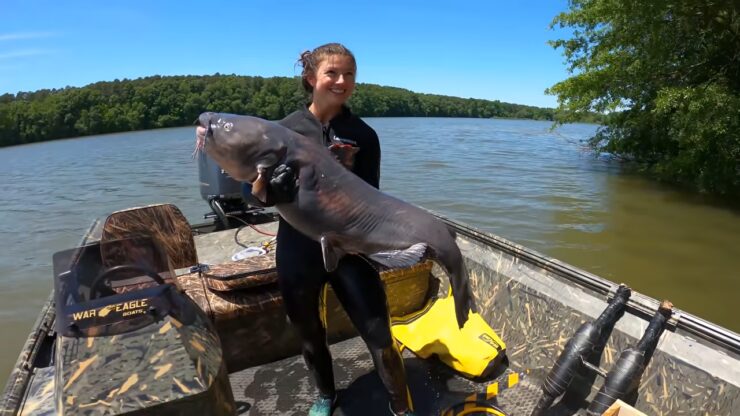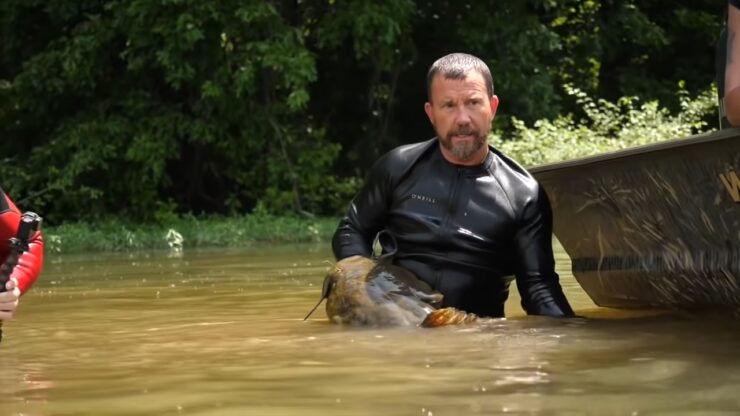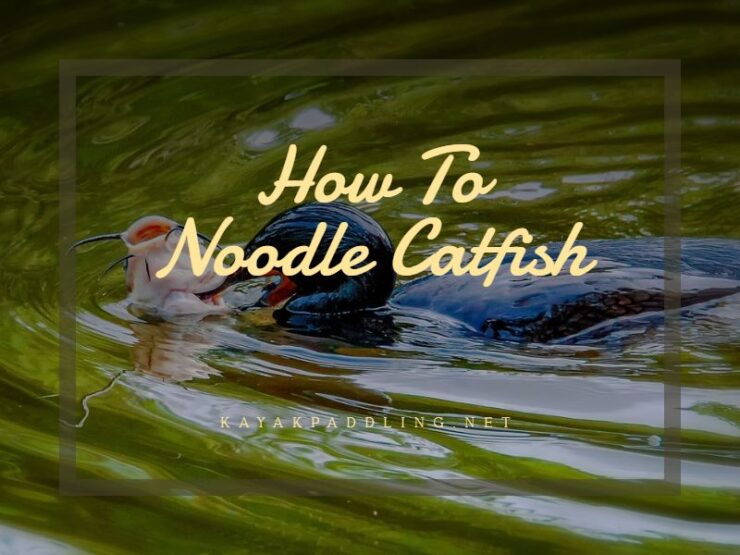These days the rage is all about Extreme things. There are Extreme sports, Extreme dancing, Extreme cooking, etc… Now it seems the trend has intruded upon the fishing world. I am speaking of a dubious sport called ‘Noodling’. Sounds pretty tame, right? Actually, it is one of the most dangerous ways of fishing I can think of, at least in freshwater.
It’s a lot like hunting wild hogs by just jumping on them bare-handed and trying to tie them up. Sounds fun…not.
Noodling is jumping into the water and sticking your arm in holes and crevices that may, or may not contain large and aggressive male catfish that are guarding their nest. You then ram your arm into their mouth, force them to bite you and drag them out of the hole by their gills, guts, or whatever you can grab. Keep in mind that catfish can approach 100 pounds, and 40 pounders are not uncommon. A 40 lb. catfish can do some serious damage to you when provoked.
Table of Contents
ToggleThe History Of Catfish Wrestling

There is plenty of archeological evidence that our ancient ancestors did practice noodling. They really had little choice, since fishing rods had not been invented, yet. They had to put food on the table. There is little doubt that even the Neanderthals practiced noodling for species that may have presented some chance of success, no matter how slight.
Native Americans also practiced noodling for the same reasons. The early Europeans recounted how the Native Americans would yank large catfish out of their lays, but they never said how many got the worst end of the deal. Early settlers had a modicum of good sense, so noodling never caught on with them.
Noodling experienced a resurgence during the Depression. People were desperate to put food on the table and could not afford a rod and reel.
This is where the family traditions involving noodling got started. Noodling was practiced mostly in the South and Midwest, probably because of the warmer water.
Noodling was always practiced by a small minority of people. In 2001, it was only legal in 4 states. But, probably because of the internet and YouTube videos, it has increased to 16 states as of 2019. At first glance, it seems a little exciting to bare-handedly battle a large fish. Catching fish is catching fish, right? Why would it make any difference whether you catch a catfish by hand, or with a rod? The truth is that it makes a huge difference, which I will get into shortly. But first, you need an understanding of what noodling entails.
How To Noodle

Noodling takes advantage of the natural life cycle of catfish. Catfish spawn all summer in the South. During spawning, the female lays eggs in any place that can be protected, such as caves, overhangs, docks, rocks, etc… Then the female bugs out and leaves the male to guard the eggs until they hatch. Not only do the eggs need protection from predators such as crawfish, other fish, and such, but they also have to be cleaned of algae, which can kill them if left to grow on them.
Without the male to guard them, the eggs have a near 100% chance of dying before they hatch. That means that several hundred catfish will never grow to adulthood. They lay thousands of eggs, but only a small percentage make it to breeding age.
Noodling is done in groups, with several people acting as safety officers in the event things go south as one person does the actual noodling.
The others also block the fish’s escape so that it has no choice but to bite the noodler. Noodlers get into the water and the point person feels around in holes and crevices until they feel something that may be a catfish. Sometimes this involves going totally submerged.
Once a catfish is located, the others block any escape path while the noodler rams his hand down the catfish’s throat, forcing it to bite down on the offending arm. Then the catfish is pulled out of the hole by grabbing whatever is handy, whether it is gills, the jaw, vital organs …whatever.
If everything goes right, the noodler will only have a scratched-up arm from the catfish’s sandpaper-like jaws, and a very increased chance of infection from things like Necrotizing fasciitis, also known as the Flesh-Eating Virus.
The Dangers Of Noodling
A lot of things can go wrong when one noodle. So far the National Safety Council has logged 69 deaths as a direct result of noodling.
Here are some of the things that can go wrong:
- You can’t see in the hole and have no idea how big the catfish is. Even a 40 lb. catfish can do some serious damage.
- If you can’t get the catfish out and can’t get your arm free, you may drown. A catfish in a hole has leverage and will have no trouble holding you under.
- If your arm or clothing gets snagged or stuck, you may drown.
- Many of the best places to noodle are near spillways and dams. Several people have been killed while noodling by being swept over dams, or downriver in fast water when floodgates open.
- Catfish aren’t the only things that hang out in holes. Snapping turtles (which can snap an arm off like a twig), beavers (with a wicked set of choppers), alligators, and water moccasins (very venomous water snakes, also known as Cottonmouths) like to hang out in those same places. They will not take kindly to having an arm intruding into their world.
And the danger is not just to the noodler. Noodling is devastating to the catfish populations. Luckily until now, it has only been practiced by small numbers of people, but if it gets popular, that would spell the eventual end of native catfish.
Here’s why:
- During the struggle, thousands of eggs are damaged.
- Without the male, all of the eggs will either be eaten by scavengers or killed by algae. That means an entire generation of catfish could be lost forever.
- Even Catch-And-Release is not possible because yanking the fish out by its gills and internal parts will damage the catfish, and probably kill it.
Most anglers and even hard-core catfish enthusiasts are against noodling. Many regard it as not a sport because the fish has no chance. And the potential damage to the environment is a very real concern. There are arguments both for and against the legalization of noodling. The ones that support noodling say it’s a family tradition, and they’ve been doing it for generations.
My take on this is that at one time, human sacrifice was a tradition, practiced for many generations. But we outgrew it. It is no longer legal, and not protected by the Freedom of Religion clause contained in the First Amendment to the Constitution of the United States. Calling something a tradition is not a good justification for something that has potentially negative effects.
What do you think? Should noodling be allowed, or not?
Happy fishing
Meet Maria Alexander, the fearless adventurer steering the ship at KayakPaddling.net. Her mission? To convince you that life’s too short for dry land and that the best stories always start with “So there I was in my kayak…”
Related Posts:
- Heavy Duty Fishing: 11 Best Rods And Reels For Big Fish 2024
- 10 Best Saltwater Fishing Boats - Ultimate Angling Adventure
- 12 Best Fishing Lures Ever 2024 - Baits That…
- 16 Best Kayak For Beginners 2024 - Kayaking Adventure Gear
- 12 Best Motorized Kayak 2024 - Start Your Aquatic Adventure!
- 10 Best Sit-Inside Fishing Kayaks 2024 -…












